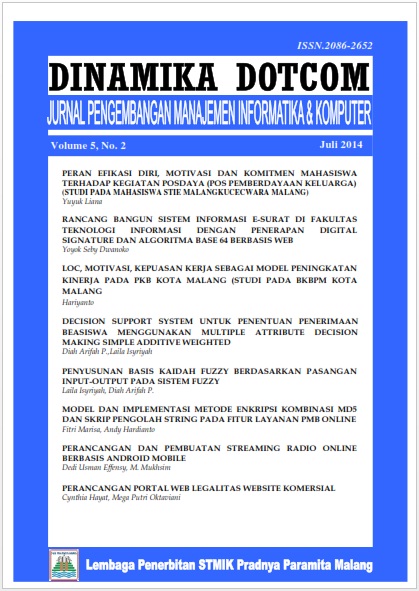PENYUSUNAN BASIS KAIDAH FUZZY BERDASARKAN PASANGAN INPUT-OUTPUT PADA SISTEM FUZZY
Abstract
The implementation of fuzzy inference system on the real problems have been carried out by researchers from different scientific disciplines. Preparation of base rules plays a very important role when there is no rule of experts or the curse of dimensionality. The results of this research can be used as a reference to build the fuzzy rule base in the fuzzy inference system and a financial time series forecasting model by a heuristic method. The data used for the implementation is Kaotis McGlass time series data. From the kaotis data sets, a total of 600 items are divided into two groups, the first 300 items are used as a data base to develop rules while the other 300 items as predicted data. From the first group of data, input-output pairs are formed and are used as a constituent of fuzzy rule base. Steps being taken are: 1). Defining fuzzy sets that cover the entire input-output space, 2). Generating the rules of every single pair of input-output, 3). Provides a degree for each rule generated, 4). Constructing a fuzzy rule base, 5). Building a fuzzy system. There are 2 cases discussed: 4 inputs with 7 fuzzy sets, and 4 inputs with 15 fuzzy sets based on the value of Mean Square Error (MSE) and Mean Absolute Percentage Error (MAPE). In the first case 37 rules are formed, while in the second case as much as 101 rules are formed. The results of prediction using fuzzy system with 101 rules are more accurate than the results with only 37 rules are used.
Keywords: Fuzzy Systems, Fuzzy Rule Base, Predictions
References
G. J. Klir, and T. A. Folger. Fuzzy Sets, Uncertainty, and Information, Prentice-Hall, New Jersey, U.S.A. 1988.
Shafiq, M.Z, Farooq, M and Khayam, A.S. A Comparative Study of Fuzzy Inference System, Neural Networks, and Adaptive Neuro Fuzzy System for Portscan Detection. NUCES. Islamabad. Pakistan. 2005.
Rahmat Wahyu, W dan Afriyanti, L. Aplikasi Fuzzy Infernce System (FIS) metode Tsukamoto pada Simulasi Traffic Light Menggunakan JAVA. SNATI. UII. Yogjakarta. 2009.
Guney, K dan Sarikaya, K. Comparison of Mamdani and Sugeno Fuzzy Inference System Models for Resonant Frequency Calculation of Rectangular Microstrip Antenas. Progress In Electromagnetics Reasearch B, Keyseri. Turkey. 2009. Vol 12, pp 81-104.
Jumingan, Analisis Laporan Keuangan, Bumi Aksara, 2009.
S. G. Makridakis, Steven C., Wheelwirght, Victor E.,McGee. Forecasting, Methodes & Aplication. ISBN UOM, 1999.
Kusumadewi, S. Artificial Intelligence (Teknik dan Aplikasinya). Graha Ilmu, Yogyakarta. 2003.
L. X. Wang, and J. M. Mendel. “Generating fuzzy rules by learning from examples”, IEEE Transactions on Systems, Man, and Cybernetics, 1992. Vol.22, pp.1414-1427.
Clements, M.P, Franses, P.H, and Swanson, N.R. Forcasting Economic dan Financial Time-series with Non-linier Models. International Journal of Forecasting. Elsevier. USA. 2004. Pp.169-183.
Q. Song, and B. S. Chissom. “Forecasting enrollments with fuzzy time series: Part II”, Fuzzy Sets and Systems, 1994.Vol. 62: pp. 1-8.
Q. Song. “A note on fuzzy time series model selection with sample autocorrelation functions”, Cybernetics and Systems: An International Journal, 2003. Vol. 34, pp. 93-107.


